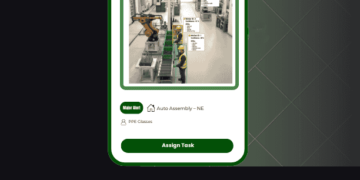In today’s web development world, full-stack applications are everywhere. They power social networks, e-commerce platforms, dashboards, and more. If you’re looking to build your own, React and MongoDB are a great combo. Together, they offer a powerful, flexible way to create fast and dynamic apps.
In this article, we’ll explore what full-stack means, how React and MongoDB work together, and how to start building your own app using them.
What is a Full-Stack Application?
A full-stack application has two main parts:
- Frontend – What users see and interact with. This is usually built with tools like React.
- Backend – What handles the data, logic, and database. This often uses Node.js, Express.js, and databases like MongoDB.
So, when we say “full-stack,” it means building both the frontend and backend of a web app.
Why Use React?
React is a JavaScript library made by Facebook. It’s popular because:
- It’s fast and responsive.
- It uses components, which makes code reusable and easy to manage.
- It has a strong community and lots of learning resources.
React makes the user experience smooth. When something updates, React updates just that part of the page, not the whole thing. This makes the app feel quick and modern.
Why Choose MongoDB?
MongoDB is a NoSQL database. Unlike SQL databases, MongoDB stores data in JSON-like documents.
Here’s why it’s a great choice:
- It’s flexible. You don’t need to define a strict structure.
- It works well with JavaScript and JSON.
- It scales easily as your app grows.
For many modern apps, MongoDB is faster and more flexible than traditional databases.
The Full Stack: React + Node.js + Express + MongoDB
This stack is often called the MERN Stack:
- M – MongoDB (database)
- E – Express.js (web framework for Node.js)
- R – React (frontend)
- N – Node.js (backend runtime)
These technologies all use JavaScript, so developers can work across the whole stack using one language. That’s a big plus.
Setting Up the Project
Let’s go through the basic setup of a full-stack app using React and MongoDB.
1. Set Up the Backend
You’ll need Node.js installed. Start by creating a new project folder and initialize a Node app:
bashCopyEditmkdir my-app
cd my-app
npm init -y
Install the required packages:
bashCopyEditnpm install express mongoose cors dotenv
- Express handles server routes.
- Mongoose connects MongoDB to Node.js.
- CORS allows communication between frontend and backend.
- Dotenv helps store environment variables.
Create a simple server in a file called server.js:
jsCopyEditconst express = require('express');
const mongoose = require('mongoose');
const cors = require('cors');
require('dotenv').config();
const app = express();
app.use(cors());
app.use(express.json());
mongoose.connect(process.env.MONGO_URI)
.then(() => console.log('MongoDB connected'))
.catch((err) => console.log(err));
app.get('/', (req, res) => {
res.send('Hello from backend!');
});
const PORT = process.env.PORT || 5000;
app.listen(PORT, () => console.log(`Server running on ${PORT}`));
In a .env file, store your MongoDB URI:
bashCopyEditMONGO_URI=mongodb://localhost:27017/mydb
2. Create a MongoDB Model
Let’s say we’re building a to-do list. Create a model for tasks.
In a file called models/Task.js:
jsCopyEditconst mongoose = require('mongoose');
const TaskSchema = new mongoose.Schema({
title: String,
completed: Boolean,
});
module.exports = mongoose.model('Task', TaskSchema);
Building the Frontend with React
Set up the frontend in a separate folder:
bashCopyEditnpx create-react-app client
cd client
npm start
This will run your React app on localhost:3000.
You can now start creating components. For example, a simple form to add a task.
In App.js:
jsCopyEditimport React, { useEffect, useState } from 'react';
function App() {
const [tasks, setTasks] = useState([]);
const [title, setTitle] = useState('');
useEffect(() => {
fetch('http://localhost:5000/tasks')
.then(res => res.json())
.then(data => setTasks(data));
}, []);
const addTask = () => {
fetch('http://localhost:5000/tasks', {
method: 'POST',
headers: { 'Content-Type': 'application/json' },
body: JSON.stringify({ title, completed: false }),
})
.then(res => res.json())
.then(newTask => setTasks([...tasks, newTask]));
};
return (
<div>
<h1>To-Do List</h1>
<input value={title} onChange={(e) => setTitle(e.target.value)} />
<button onClick={addTask}>Add Task</button>
<ul>
{tasks.map((task) => (
<li key={task._id}>{task.title}</li>
))}
</ul>
</div>
);
}
export default App;
Make sure to update the backend to handle /tasks routes using Express and the Task model.
Connecting Frontend and Backend
To allow the frontend to talk to the backend:
- Ensure the backend is running on port 5000.
- Use CORS in Express.
- In React, fetch data from
Web Peak.
You can now add, get, and display tasks in your full-stack app!
Hosting Your Application
Once your app is working locally, you can deploy it.
- Frontend (React): Use platforms like Vercel, Netlify, or host it on Firebase.
- Backend (Node.js/Express): Use Render, Railway, Heroku, or DigitalOcean.
- MongoDB: Use MongoDB Atlas for free cloud hosting.
These services make it easy to get your app online and share it with the world.
Final Thoughts
Building full-stack apps may sound complex at first, but with tools like React and MongoDB, it’s very doable—even for beginners. You write both the frontend and backend in JavaScript, and MongoDB makes storing data easy.
Start small. Build a to-do app or a notes app. Then try more features—login, filters, or even real-time chat. The more you practice, the more confident you’ll become.
React and MongoDB are a powerful pair. With them, you can turn your ideas into real-world applications.


















